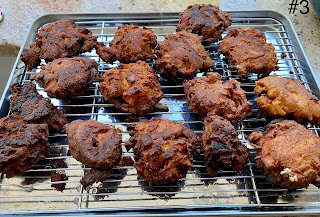The original recipe came from “Serious eats”.
Ingredients
For the apples:
226 g granny smith apples (we used two honey crisp apples, peeled, cored and diced in small pieces)
42g unsalted butter (1 1/2 ounces; 3 tablespoons)
2 teaspoons fresh lemon juice
1/2 cup sugar
1 teaspoon plus a pinch kosher salt
For the dough:
355 g all purpose flour
2 teaspoons baking powder
3/4 teaspoons apple pie spice*
2 large eggs, lightly beaten
1/2 cup whole milk
1/3 cup sour cream
1 teaspoon vanilla extract
Canola oil, for frying
*Apple pie spice: 1 tsp. ground cinnamon, 1/4 tsp nutmeg, 1/2 tsp ginger and 1/2 tsp cardamon.
Directions:
In a large skillet, melt butter over medium heat. Cook, whisking constantly with a wooden spoon, until milk solids sink to the bottom of the skillet and turn light golden brown, 3 to 4 minutes. Add apples and stir to evenly coat in butter. Cook, stirring occasionally, until apples are crisp-tender and still hold their shape, about 5 minutes. Add lemon juice, 2 tablespoons of the sugar, and a pinch of salt. Cook, stirring constantly, until sugar dissolves and apples are glazed in sugar mixture, about 2 minutes. Transfer apples to a large plate and refrigerate until cool, about 20 minutes.
Set a wire rack inside a 13- by 18-inch rimmed baking sheet; set aside. Fill a large Dutch oven with 1 1/2 inches of canola oil and heat over medium-high until oil is 375ºF (190ºC).
In a large bowl, whisk flour, baking powder, apple pie spice, remaining 1/2 cup sugar, and 1 teaspoon salt to combine; set aside. In a medium bowl, whisk eggs, milk, sour cream, and vanilla to combine. Add sour cream mixture and cooked apples to dry ingredients, and, using a flexible spatula, fold together until a thick batter forms.
Working in batches carefully drop about 1/2 cup of batter into the hot oil and, using the back of a spoon, immediately press fritter until fritter is about 4-inches in diameter. Fry, adjusting heat as needed to maintain temperature, and use a spider skimmer or slotted spoon to flip fritters halfway through. Cook until fritters are browned, puffed, and cooked through, about 5 minutes (picture #2). Transfer finished fritters to prepared wire rack and repeat with remaining fritters (picture #3).
This recipe made a quite large amount (picture #3). The fritter heated up very well in the toaster oven. They were quite a treat (Can’t go wrong with sweet, spicy, fried bread.) The outside had a wonderful crunch and the inside was soft and sweetly spicy. The apple gave a burst of sweet fruit taste.
1/2 cup whole milk
1/3 cup sour cream
1 teaspoon vanilla extract
Canola oil, for frying
*Apple pie spice: 1 tsp. ground cinnamon, 1/4 tsp nutmeg, 1/2 tsp ginger and 1/2 tsp cardamon.
Directions:
In a large skillet, melt butter over medium heat. Cook, whisking constantly with a wooden spoon, until milk solids sink to the bottom of the skillet and turn light golden brown, 3 to 4 minutes. Add apples and stir to evenly coat in butter. Cook, stirring occasionally, until apples are crisp-tender and still hold their shape, about 5 minutes. Add lemon juice, 2 tablespoons of the sugar, and a pinch of salt. Cook, stirring constantly, until sugar dissolves and apples are glazed in sugar mixture, about 2 minutes. Transfer apples to a large plate and refrigerate until cool, about 20 minutes.
Set a wire rack inside a 13- by 18-inch rimmed baking sheet; set aside. Fill a large Dutch oven with 1 1/2 inches of canola oil and heat over medium-high until oil is 375ºF (190ºC).
In a large bowl, whisk flour, baking powder, apple pie spice, remaining 1/2 cup sugar, and 1 teaspoon salt to combine; set aside. In a medium bowl, whisk eggs, milk, sour cream, and vanilla to combine. Add sour cream mixture and cooked apples to dry ingredients, and, using a flexible spatula, fold together until a thick batter forms.
Working in batches carefully drop about 1/2 cup of batter into the hot oil and, using the back of a spoon, immediately press fritter until fritter is about 4-inches in diameter. Fry, adjusting heat as needed to maintain temperature, and use a spider skimmer or slotted spoon to flip fritters halfway through. Cook until fritters are browned, puffed, and cooked through, about 5 minutes (picture #2). Transfer finished fritters to prepared wire rack and repeat with remaining fritters (picture #3).
This recipe made a quite large amount (picture #3). The fritter heated up very well in the toaster oven. They were quite a treat (Can’t go wrong with sweet, spicy, fried bread.) The outside had a wonderful crunch and the inside was soft and sweetly spicy. The apple gave a burst of sweet fruit taste.


















